Recent Developments in Polyurea Research for Enhanced Impact Penetration Resistance and Blast Mitigation
Abstract
1. Introduction
2. Structural Characteristics of Polyurea Molecules and Material Optimization
2.1. Structural Features of Polyurea Molecules
2.2. Optimization of Polyurea Composition
2.3. Introduction of Enhanced Materials
3. Protection Mechanism under Blast Impact Loading and Ballistic Penetration
3.1. Hydrogen Bond Dissociation and Reorganization, Rearrangement and Hardening of Soft and Hard Segments
3.2. Viscous Dissipation and Strain Rate Effects within the Material
3.3. Impedance Mismatch between Base Material and Polyurea
4. Research and Application of Polyurea in Blast/Impact Protection
4.1. Construction and Infrastructure
4.2. Military and Defense
4.3. Transportation
4.4. Industrial Products and Facilities
5. Conclusions and Outlook
Author Contributions
Funding
Data Availability Statement
Conflicts of Interest
Dual-use Research Statement
- Ø
- Explanation of Potential Risks: Our paper examines the protective properties of armor materials. The research is limited to providing some theoretical and experimental support for the development of impact dynamics only and does not pose a threat to public health or national security.
- Ø
- Evaluation of Benefits to the General Public: Our research is limited to the academic field, which is beneficial to the development of material science. There is no risk to the general public.
- Ø
- Compliance with Laws: As an ethical responsibility, we strictly adhere to relevant national and international laws about dual-use research. And we have considered and adhered to these regulations in our paper.
References
- Si, P.; Liu, Y.; Yan, J.; Bai, F.; Huang, F. Ballistic Performance of Polyurea-Reinforced Ceramic/Metal Armor Subjected to Projectile Impact. Materials 2022, 15, 3918. [Google Scholar] [CrossRef]
- Chu, D.; Wang, Y.; Yang, S.; Li, Z.; Zhuang, Z.; Liu, Z. Analysis and design for the comprehensive ballistic and blast resistance of polyurea-coated steel plate. Def. Technol. 2023, 19, 35–51. [Google Scholar] [CrossRef]
- Zhang, L.; Ji, C.; Wang, X.; Wang, Y.; Wu, G.; Zhu, H.; Han, Z. Strengthening and converse strengthening effects of polyurea layer on polyurea–steel composite structure subjected to combined actions of blast and fragments. Thin-Walled Struct. 2022, 178, 109527. [Google Scholar] [CrossRef]
- Zhang, L.; Wang, X.; Wang, Y.; Gu, J.; Ji, C.; Wu, G.; Cheng, L. High-hardness polyurea coated steel plates subjected to combined loadings of shock wave and fragments. Lat. Am. J. Solids Struct. 2022, 19, e433. [Google Scholar] [CrossRef]
- Tse, K.M.; Bin Tan, L.; Bin Sapingi, M.A.; Franklyn, M.; Lee, P.V.S.; Tan, V.B.C.; Lee, H.P. The role of a composite polycarbonate-aerogel face shield in protecting the human brain from blast-induced injury: A fluid–structure interaction (FSI) study. J. Sandw. Struct. Mater. 2017, 21, 2484–2511. [Google Scholar] [CrossRef]
- Valverde-Marcos, B.; Rubio, I.; Antona-Makoshi, J.; Chawla, A.; Loya, J.A.; Rodríguez-Millán, M. Numerical Analysis of EOD Helmet under Blast Load Events Using Human Head Model. Appl. Sci. 2020, 10, 8227. [Google Scholar] [CrossRef]
- Grujicic, M.; Snipes, J.S.; Ramaswami, S. Multi-scale computational analysis of the nano-indentation and nano-scratch testing of Kevlar (R) 49 single fibers. Proc. Inst. Mech. Eng. Part L-J. Mater.-Design Appl. 2018, 232, 495–513. [Google Scholar] [CrossRef]
- Grujicic, M.; Ramaswami, S.; Snipes, J.; Dudt, P. Potential improvement in helmet blast-protection via the use of a polyurea external coating: Combined experimental/computational analyses. Proc. Inst. Mech. Eng. Part L J. Mater. Des. Appl. 2016, 234, 337–367. [Google Scholar] [CrossRef]
- Chang, C.-P.; Shih, C.-H.; You, J.-L.; Youh, M.-J.; Liu, Y.-M.; Ger, M.-D. Preparation and Ballistic Performance of a Multi-Layer Armor System Composed of Kevlar/Polyurea Composites and Shear Thickening Fluid (STF)-Filled Paper Honeycomb Panels. Polymers 2021, 13, 3080. [Google Scholar] [CrossRef]
- Shih, C.-H.; You, J.-L.; Lee, Y.-L.; Cheng, A.-Y.; Chang, C.-P.; Liu, Y.-M.; Ger, M.-D. Design and Ballistic Performance of Hybrid Plates Manufactured from Aramid Composites for Developing Multilayered Armor Systems. Polymers 2022, 14, 5026. [Google Scholar] [CrossRef] [PubMed]
- Chundawat, T.; Vaya, D.; Sini, N.; Varma, I. Blast mitigation using FRP retrofitting and coating techniques. Polym. Compos. 2016, 39, 1389–1402. [Google Scholar] [CrossRef]
- Petre, R.; Zecheru, T.; Petrea, N.; Ginghina, R.; Sandu, S.; Muresan, M.; Matache, L.C.; Sava, A.C.; Neatu, F. Synthesis and Mechanical Properties of Polyurea-Based Hybrid Composites for Ballistic Individual Protection. Mater. Plast. 2018, 55, 315–319. [Google Scholar] [CrossRef]
- Li, H.; Wang, D.; Xiao, Z.; Qin, Z.; Xiong, J.; Han, Q.; Wang, X. Investigation of vibro-impact resistance of fiber reinforced composite plates with polyurea coating with elastic constraints. Aerosp. Sci. Technol. 2022, 121, 107196. [Google Scholar] [CrossRef]
- Li, H.; Wang, D.; Zhang, H.; Wang, X.; Qin, Z.; Guan, Z. Optimal design of vibro-impact resistant fiber reinforced composite plates with polyurea coating. Compos. Struct. 2022, 292, 115680. [Google Scholar] [CrossRef]
- Zhou, J.-N.; Chen, X.-S.; Zhou, Y.-Z.; Wang, W.-Y.; Wang, P.; Kong, X.-L.; Xu, Y.; Geng, H.-S.; Jin, F.-N. Blast responses of polyurea retrofitted utility tunnel reinforced with basalt fibre reinforced polymer bars. Def. Technol. 2022, 18, 755–771. [Google Scholar] [CrossRef]
- Sun, Y.-X.; Wang, X.; Ji, C.; Zhao, C.-X.; Liu, P.-L.; Meng, L.; Zhang, K.; Jiang, T. Experimental investigation on anti-penetration performance of polyurea-coated ASTM1045 steel plate subjected to projectile impact. Def. Technol. 2021, 17, 1496–1513. [Google Scholar] [CrossRef]
- Lv, J.; Liu, Y.; Qin, Y.; Yin, Q.; Chen, S.; Cheng, Z.; Yin, J.; Dai, Y.; Liu, Y.; Liu, X. Constructing “Rigid-and-Soft” interlocking stereoscopic interphase structure of aramid fiber composites with high interfacial shear strength and toughness. Compos. Part A Appl. Sci. Manuf. 2021, 145, 106386. [Google Scholar] [CrossRef]
- Nguyen-Van, V.; Wickramasinghe, S.; Ghazlan, A.; Nguyen-Xuan, H.; Tran, P. Uniaxial and biaxial bioinspired interlocking composite panels subjected to dynamic loadings. Thin-Walled Struct. 2020, 157, 107023. [Google Scholar] [CrossRef]
- Zhang, R.; Huang, W.; Lyu, P.; Yan, S.; Wang, X.; Ju, J. Polyurea for Blast and Impact Protection: A Review. Polymers 2022, 14, 2670. [Google Scholar] [CrossRef] [PubMed]
- Cui, J.; Shi, Y.; Zhang, X.; Huang, W.; Ma, M. Experimental study on the tension and puncture behavior of spray polyurea at high strain rates. Polym. Test. 2021, 93, 106863. [Google Scholar] [CrossRef]
- Sonnenschein, M.F.; Virgili, J.M.; Larive, M.Z.; Wendt, B.L. Synthesis of aniline-terminated polyethers and resulting polyurethane/polyurea elastomers. J. Polym. Sci. Part A Polym. Chem. 2018, 56, 1730–1742. [Google Scholar] [CrossRef]
- Toader, G.; Moldovan, A.E.; Diacon, A.; Dirloman, F.M.; Rusen, E.; Podaru, A.; Rotariu, T.; Ginghina, R.E.; Hoza, O.E. Effect of Aromatic Chain Extenders on Polyurea and Polyurethane Coatings Designed for Defense Applications. Polymers 2023, 15, 756. [Google Scholar] [CrossRef] [PubMed]
- Shahi, V.; Alizadeh, V.; Amirkhizi, A.V. Thermo-mechanical characterization of polyurea variants. Mech. Time-Dependent Mater. 2020, 25, 447–471. [Google Scholar] [CrossRef]
- Guo, H.; Du, C.; Chen, Y.; Li, D.; Hu, W.; Lv, X. Study on protective performance of impact-resistant polyurea and its coated concrete under impact loading. Constr. Build. Mater. 2022, 340, 127749. [Google Scholar] [CrossRef]
- Qin, B.; Zhang, S.; Sun, P.; Tang, B.; Yin, Z.; Cao, X.; Chen, Q.; Xu, J.; Zhang, X. Tough and Multi-Recyclable Cross-Linked Supramolecular Polyureas via Incorporating Noncovalent Bonds into Main-Chains. Adv. Mater. 2020, 32, e2000096. [Google Scholar] [CrossRef]
- Zhang, L.; Wang, D.; Xu, L.; Zhang, X.; Zhang, A.; Xu, Y. A highly stretchable, transparent, notch-insensitive self-healing elastomer for coating. J. Mater. Chem. C 2020, 8, 2043–2053. [Google Scholar] [CrossRef]
- Roy, A.S.; Mitra, N.; Ghosh, S. Investigating the molecular origins of deformation in polyurea. Polymer 2022, 262, 125474. [Google Scholar] [CrossRef]
- Liu, Q.; Chen, P.-W.; Guo, Y.-S.; Su, J.-J.; Han, L.; Arab, A.; Yuan, J.-F. Mechanical behavior and failure mechanism of polyurea nanocomposites under quasi-static and dynamic compressive loading. Def. Technol. 2021, 17, 495–504. [Google Scholar] [CrossRef]
- Wu, G.; Fang, Z.; Qin, X.; Fu, J. Preparation and Properties of Impact Resistant Polyurea Coating for Fluorochemical Pipeline. Processes 2022, 10, 193. [Google Scholar] [CrossRef]
- Kumar, N.; Gupta, P.K.; Khilari, S.; Ranganath, K.V.S. Synthesis, characterization and catalytic application of functionalized polyureas. J. Polym. Res. 2023, 30, 104. [Google Scholar] [CrossRef]
- Rosenbloom, S.I.; Yang, S.J.; Tsakeredes, N.J.; Fors, B.P.; Silberstein, M.N. Microstructural evolution of polyurea under hydrostatic pressure. Polymer 2021, 227, 123845. [Google Scholar] [CrossRef]
- Li, T.; Zhang, C.; Xie, Z.; Xu, J.; Guo, B.-H. A multi-scale investigation on effects of hydrogen bonding on micro-structure and macro-properties in a polyurea. Polymer 2018, 145, 261–271. [Google Scholar] [CrossRef]
- Tzelepis, D.A.; Suzuki, J.; Su, Y.F.; Wang, Y.; Lim, Y.C.; Zayernouri, M.; Ginzburg, V.V. Effect of aromatic chain extenders on polyurea and polyurethane coatings designed for defense applications. J. Appl. Polym. Sci. 2023, 140, 10. [Google Scholar] [CrossRef]
- Zhang, L.; Wang, X.; Ji, C.; Wang, Y.; Yang, G.; Zhao, C.; Tao, C. Effect of polyurea coating with different mechanical properties on blast resistance of aluminum alloy circular tube structures: Experiments vs numerical simulations. Thin-Walled Struct. 2023, 183, 110361. [Google Scholar] [CrossRef]
- Akl, W.; Ali, M.; Aldraihem, O.; Baz, A. Dynamic behavior of polyurea composites subjected to high strain rate loading. Finite Elem. Anal. Des. 2021, 186, 103501. [Google Scholar] [CrossRef]
- Guo, H.; Zhou, Z.; Gu, M.; Yu, A.; Ling, X.; Yao, W. Preparation of impact-resistant functional polyurea coatings and effect of γ-ray irradiation on its microstructure and performance. Prog. Org. Coat. 2021, 161, 106521. [Google Scholar] [CrossRef]
- Goswami, A.; Das Adhikary, S. Retrofitting materials for enhanced blast performance of Structures: Recent advancement and challenges ahead. Constr. Build. Mater. 2019, 204, 224–243. [Google Scholar] [CrossRef]
- Manav, M.; Ortiz, M. Molecular dynamics study of the shock response of polyurea. Polymer 2021, 212, 123109. [Google Scholar] [CrossRef]
- Iqbal, N.; Tripathi, M.; Parthasarathy, S.; Kumar, D.; Roy, P.K. Polyurea coatings for enhanced blast-mitigation: A review. RSC Adv. 2016, 6, 109706–109717. [Google Scholar] [CrossRef]
- Sun, Y.; Kooi, S.E.; Nelson, K.A.; Hsieh, A.J.; Veysset, D. Impact-induced glass-to-rubber transition of polyurea under high-velocity temperature-controlled microparticle impact. Appl. Phys. Lett. 2020, 117, 021905. [Google Scholar] [CrossRef]
- Huang, W.; Zhang, R.; Wang, X.; Lyu, P.; Ju, J.; Gao, F.; Yan, S. Study of Blast Mitigation Performance and Fracture Mechanism of Polyurea under Contact Explosion. Polymers 2022, 14, 3458. [Google Scholar] [CrossRef] [PubMed]
- Zhang, R.; Huang, W.; Lyu, P.; Sun, P.; Fang, Z.; Wang, R. Study on the performance of blast-mitigation polyurea and fracture mechanism of the coated reinforced concrete slabs under contact explosion. Adv. Eng. Sci. 2022, 54, 218–227. [Google Scholar]
- Jandaghian, M.H.; Kazerooni, H. Performance of polyurea formulations against impact loads: A molecular dynamics and mechanical simulation approach. J. Appl. Polym. Sci. 2020, 138, 50309. [Google Scholar] [CrossRef]
- Iqbal, N.; Tripathi, M.; Parthasarathy, S.; Kumar, D.; Roy, P.K. Tuning the properties of segmented polyurea by regulating soft-segment length. J. Appl. Polym. Sci. 2018, 135, 46284. [Google Scholar] [CrossRef]
- Sun, Y.; Wu, Y.-C.M.; Veysset, D.; Kooi, S.E.; Hu, W.; Swager, T.M.; Nelson, K.A.; Hsieh, A.J. Molecular dependencies of dynamic stiffening and strengthening through high strain rate microparticle impact of polyurethane and polyurea elastomers. Appl. Phys. Lett. 2019, 115, 093701. [Google Scholar] [CrossRef]
- Yao, K.; Chu, D.; Li, T.; Liu, Z.; Guo, B.-H.; Xu, J.; Zhuang, Z. Atomic-scale simulation of hugoniot relations and energy dissipation of polyurea under high-speed shock. Eng. Comput. 2020, 38, 1209–1225. [Google Scholar] [CrossRef]
- Yao, K.; Liu, Z.; Li, T.; Guo, B.; Zhuang, Z. Mesoscale structure-based investigation of polyurea dynamic modulus and shock-wave dissipation. Polymer 2020, 202, 122741. [Google Scholar] [CrossRef]
- Akl, W.; Nouh, M.; Aldraihem, O.; Baz, A. Energy dissipation characteristics of polyurea and polyurea/carbon black composites. Mech. Time-Dependent Mater. 2019, 23, 223–247. [Google Scholar] [CrossRef]
- Chen, D.; Wu, H.; Wei, J.S.; Xu, S.L.; Fang, Q. Nonlinear visco-hyperelastic tensile constitutive model of spray polyurea within wide strain-rate range. Int. J. Impact Eng. 2022, 163, 104184. [Google Scholar] [CrossRef]
- Chen, Y.; Guo, H.; Sun, M.; Lv, X. Tensile Mechanical Properties and Dynamic Constitutive Model of Polyurea Elastomer under Different Strain Rates. Polymers 2022, 14, 3579. [Google Scholar] [CrossRef]
- Wang, X.; Ji, H.; Li, X.; Sun, S.; Zhang, Q.; Shim, V.; Lu, T.J. Static and dynamic compressive and tensile response of highly stretchable polyurea. Int. J. Impact Eng. 2022, 166, 104250. [Google Scholar] [CrossRef]
- Wang, H.; Deng, X.; Wu, H.; Pi, A.; Li, J.; Huang, F. Investigating the dynamic mechanical behaviors of polyurea through experimentation and modeling. Def. Technol. 2019, 15, 875–884. [Google Scholar] [CrossRef]
- Fan, J.; Chen, A. Studying a Flexible Polyurethane Elastomer with Improved Impact-Resistant Performance. Polymers 2019, 11, 467. [Google Scholar] [CrossRef] [PubMed]
- Wu, G.; Wang, X.; Ji, C.; Gao, Z.; Jiang, T.; Zhao, C.; Liu, Y. Anti-blast properties of 6063-T5 aluminum alloy circular tubes coated with polyurea elastomer: Experiments and numerical simulations. Thin-Walled Struct. 2021, 164, 107842. [Google Scholar] [CrossRef]
- Li, B.; Zhang, Z.; Wang, X.; Liu, X. Investigation on the Debonding Failure Model of Anchored Polyurea Coating under a High-Velocity Water Flow and Its Application. Sustainability 2019, 11, 1261. [Google Scholar] [CrossRef]
- He, L.; Attard, T.L.; Zhou, H.; Brooks, A. Integrating energy transferability into the connection-detail of coastal bridges using reinforced interfacial epoxy-polyurea reaction matrix composite. Compos. Struct. 2019, 216, 89–103. [Google Scholar] [CrossRef]
- Rijensky, O.; Rittel, D. Numerical investigation of polyurea coated aluminum plates under hydrodynamic shocks. Thin-Walled Struct. 2021, 166, 108074. [Google Scholar] [CrossRef]
- Dewapriya, M.; Miller, R. Molecular dynamics study of the mechanical behaviour of ultrathin polymer–metal multilayers under extreme dynamic conditions. Comput. Mater. Sci. 2020, 184, 109951. [Google Scholar] [CrossRef]
- Chen, C.; Wang, X.; Hou, H.; Cheng, Y.; Zhang, P.; Liu, J. Effect of strength matching on failure characteristics of polyurea coated thin metal plates under localized air blast loading: Experiment and numerical analysis. Thin-Walled Struct. 2020, 154, 106819. [Google Scholar] [CrossRef]
- Nantasetphong, W.; Jia, Z.; Hasan, M.; Amirkhizi, A.; Nemat-Nasser, S. A New Technique for Characterization of Low Impedance Materials at Acoustic Frequencies. Exp. Mech. 2018, 58, 1311–1324. [Google Scholar] [CrossRef]
- Yao, K.; Liu, Z.; Zhuang, Z. Atomic insights into shock-induced spalling of polyurea by molecular dynamics simulation. Extrem. Mech. Lett. 2022, 55, 101805. [Google Scholar] [CrossRef]
- Rahimzadeh, T.; Arruda, E.M.; Thouless, M.D. Design of armor for protection against blast and impact. J. Mech. Phys. Solids 2015, 85, 98–111. [Google Scholar] [CrossRef]
- Chu, D.; Li, Z.; Yao, K.; Wang, Y.; Tian, R.; Zhuang, Z.; Liu, Z. Studying the strengthening mechanism and thickness effect of elastomer coating on the ballistic-resistance of the polyurea-coated steel plate. Int. J. Impact Eng. 2022, 163, 104181. [Google Scholar] [CrossRef]
- Wu, G.; Wang, X.; Ji, C.; Liu, Q.; Xie, X.; Zhao, C.; Liu, P. Damage response of polyurea-coated steel plates under combined blast and fragments loading. J. Constr. Steel Res. 2022, 190, 107126. [Google Scholar] [CrossRef]
- Gu, M.; Ling, X.; Wang, H.; Yu, A.; Chen, G. Experimental and Numerical Study of Polymer-Retrofitted Masonry Walls under Gas Explosions. Processes 2019, 7, 863. [Google Scholar] [CrossRef]
- Zhang, L.; Wang, Y.; Wang, X.; Ji, C.; Gu, J.; Zhao, C. Investigation on the influence mechanism of polyurea material property on the blast resistance of polyurea-steel composite plate. Structures 2022, 44, 1910–1927. [Google Scholar] [CrossRef]
- Chen, Y.; Jian, Z.; Xiao, S.; Wang, L.; Li, X.; Wang, K.; Deng, H.; Hu, W. Molecular dynamics simulation of shock wave propagation and spall failure in single crystal copper under cylindrical impact. Appl. Phys. Express 2021, 14, 075504. [Google Scholar] [CrossRef]
- Dewapriya, M.; Miller, R. Energy absorption mechanisms of nanoscopic multilayer structures under ballistic impact loading. Comput. Mater. Sci. 2021, 195, 110504. [Google Scholar] [CrossRef]
- Lee, T.-H.; Park, J.-H.; Yang, D.-H.; Kim, J.-H.J.; Noor, N.B.M. Material enhancements of newly developed stiff type polyurea for retrofitting of concrete structures. Case Stud. Constr. Mater. 2022, 17, e01431. [Google Scholar] [CrossRef]
- Fan, W.; Xie, R.; Davidson, M.; Yin, H.; Lai, K.; Wu, Q. Crashworthiness and energy absorption of UHPFRC-steel composite sandwich structures under impact loading. Compos. Struct. 2023, 311, 116813. [Google Scholar] [CrossRef]
- Wang, X.; Yue, Z.; Xu, X.; Zhao, Z.; Ji, H.; Zhu, M.; Wang, P.; Zhang, Q.; Lu, T.J. Ballistic impact response of elastomer-retrofitted corrugated core sandwich panels. Int. J. Impact Eng. 2023, 175, 104545. [Google Scholar] [CrossRef]
- Wu, J.; Liu, Z.; Yu, J.; Xu, S. Experimental and numerical investigation of normal reinforced concrete panel strengthened with polyurea under near-field explosion. J. Build. Eng. 2022, 46, 103763. [Google Scholar] [CrossRef]
- Fallon, C.; McShane, G. Impact mitigating capabilities of a spray-on elastomer coating applied to concrete. Int. J. Impact Eng. 2019, 128, 72–85. [Google Scholar] [CrossRef]
- El-Sisi, A.E.; Saucier, A.; Salim, H.A.; Hoemann, J.M. Experimental and Numerical Evaluation of Reinforced Concrete Walls Retrofit Systems for Blast Mitigation. J. Perform. Constr. Facil. 2019, 33, 2. [Google Scholar] [CrossRef]
- Iqbal, N.; Sharma, P.; Kumar, D.; Roy, P. Protective polyurea coatings for enhanced blast survivability of concrete. Constr. Build. Mater. 2018, 175, 682–690. [Google Scholar] [CrossRef]
- Shi, C.; Zhang, J.; Wang, X.; Liu, F.; Chen, W.; Ma, Z.; Liang, H.; Zhao, Y. Improving the Impact Resistance and Antisplash of Civil Air Defense Wall: Experiments and Finite-Element Simulation. J. Struct. Eng. 2023, 149, 04022238. [Google Scholar] [CrossRef]
- Lyu, P.; Fang, Z.; Wang, X.; Huang, W.; Zhang, R.; Sang, Y.; Sun, P. Explosion Test and Numerical Simulation of Coated Reinforced Concrete Slab Based on BLAST Mitigation Polyurea Coating Performance. Materials 2022, 15, 2607. [Google Scholar] [CrossRef] [PubMed]
- Chen, Y.-S.; Wang, B.; Zhang, B.; Zheng, Q.; Zhou, J.-N.; Jin, F.-N.; Fan, H.-L. Polyurea coating for foamed concrete panel: An efficient way to resist explosion. Def. Technol. 2020, 16, 136–149. [Google Scholar] [CrossRef]
- Zhang, Y.; Hu, J.; Zhao, W.; Hu, F.; Yu, X. Numerical Simulation of the Blast Resistance of SPUA Retrofitted CMU Masonry Walls. Buildings 2023, 13, 446. [Google Scholar] [CrossRef]
- Ji, L.; Wang, P.; Cai, Y.; Shang, W.; Zu, X. Blast Resistance of 240 mm Building Wall Coated with Polyurea Elastomer. Materials 2022, 15, 850. [Google Scholar] [CrossRef]
- Gu, M.; Wang, H.; Yu, A.; Wang, H.; Ling, X.; Chen, G. Research on dynamic behavior and gas explosion resistance of polyurea. Mater. Today Commun. 2022, 33, 104826. [Google Scholar] [CrossRef]
- Liu, Q.; Guo, B.; Chen, P.; Zhai, H.; Guo, Y.; Tang, S. Experimental investigation blast resistance of CFRP/polyurea composite plates under blast loading. Thin-Walled Struct. 2022, 181, 110149. [Google Scholar] [CrossRef]
- Li, Z.; Chen, L.; Fang, Q.; Chen, W.; Hao, H.; Zhu, R.; Zheng, K. Experimental and numerical study on CFRP strip strengthened clay brick masonry walls subjected to vented gas explosions. Int. J. Impact Eng. 2019, 129, 66–79. [Google Scholar] [CrossRef]
- Wu, G.; Ji, C.; Wang, X.; Gao, F.-Y.; Zhao, C.-X.; Liu, Y.-J.; Yang, G.-L. Blast response of clay brick masonry unit walls unreinforced and reinforced with polyurea elastomer. Def. Technol. 2021, 18, 643–662. [Google Scholar] [CrossRef]
- Zhu, H.; Wang, X.; Wang, Y.; Ji, C.; Wu, G.; Zhang, L.; Han, Z. Damage behavior and assessment of polyurea sprayed reinforced clay brick masonry walls subjected to close-in blast loads. Int. J. Impact Eng. 2022, 167, 104283. [Google Scholar] [CrossRef]
- Lantz, L.; Maynez, J.; Cook, W.; Wilson, C.M.D. Blast Protection of Unreinforced Masonry Walls: A State-of-the-Art Review. Adv. Civ. Eng. 2016, 2016, 8958429. [Google Scholar] [CrossRef]
- Akın, E.; Tunaboyu, O.; Avşar, Ö. Axial behavior of FRP confined low-strength concrete with polyurea. Structures 2020, 28, 1774–1784. [Google Scholar] [CrossRef]
- Song, J.-H.; Lee, E.-T.; Eun, H.-C. A Study on the Strengthening Performance of Concrete Beam by Fiber-Reinforced Polyurea (FRPU) Reinforcement. Adv. Civ. Eng. 2020, 2020, 6967845. [Google Scholar] [CrossRef]
- Szafran, J.; Matusiak, A.; Rzeszut, K.; Jankowiak, I. The influence of a polyurea coating on bent reinforced concrete beams with various reinforcement ratios. Bull. Pol. Acad. Sci.-Tech. Sci. 2023, 71, 1–7. [Google Scholar] [CrossRef]
- Song, J.-H.; Lee, E.-T.; Eun, H.-C. A Study on the Improvement of Structural Performance by Glass Fiber-Reinforced Polyurea (GFRPU) Reinforcement. Adv. Civ. Eng. 2019, 2019, 2818219. [Google Scholar] [CrossRef]
- Shi, S.; Liao, Y.; Peng, X.; Liang, C.; Sun, J. Behavior of polyurea-woven glass fiber mesh composite reinforced RC slabs under contact explosion. Int. J. Impact Eng. 2019, 132, 103335. [Google Scholar] [CrossRef]
- Liu, Y.; Wang, P.; Jin, F.; He, H.; Zhou, Y.; Chen, H.; Zhou, J.; Wang, B.; Fan, H. Blast responses of polyurea-coated concrete arches. Arch. Civ. Mech. Eng. 2021, 21, 1–15. [Google Scholar] [CrossRef]
- Yue, Z.; Zhou, J.; Kong, X.; Xu, Y.; Chen, Y.; Wang, B.; Huang, Y.; Wang, P. Anti-Blast Performance of Polyurea-Coated Concrete Arch Structures. Polymers 2023, 15, 1263. [Google Scholar] [CrossRef]
- Liu, Q.; Guo, B.Q.; Chen, P.W.; Su, J.J.; Arab, A.; Ding, G.; Yan, G.H.; Jiang, H.Y.; Guo, F. length Investigating ballistic resistance of CFRP/polyurea composite plates subjected to ballistic impact. Thin-Walled Struct. 2021, 166, 13. [Google Scholar] [CrossRef]
- Petre, R.; Zecheru, T.; Ginghina, R. Dynamic Tests on Polyurea-Based Hybrid Composites for Ballistic Protection. Mater. Plast. 2021, 58, 41–47. [Google Scholar] [CrossRef]
- Bucur, F.; Trana, E.; Rotariu, A. Numerical and Experimental Study on the Locally Blast Loaded Polyurea Coated Steel Plates. Mater. Plast. 2019, 56, 492–499. [Google Scholar] [CrossRef]
- Li, Y.; Chen, C.; Hou, H.; Cheng, Y.; Gao, H.; Zhang, P.; Liu, T. The Influence of Spraying Strategy on the Dynamic Response of Polyurea-Coated Metal Plates to Localized Air Blast Loading: Experimental Investigations. Polymers 2019, 11, 1888. [Google Scholar] [CrossRef] [PubMed]
- Hou, H.; Chen, C.; Cheng, Y.; Zhang, P.; Tian, X.; Liu, T.; Wang, J. Effect of structural configuration on air blast resistance of polyurea-coated composite steel plates: Experimental studies. Mater. Des. 2019, 182, 108049. [Google Scholar] [CrossRef]
- Mohotti, D.; Fernando, P.; Weerasinghe, D.; Remennikov, A. Evaluation of effectiveness of polymer coatings in reducing blast-induced deformation of steel plates. Def. Technol. 2020, 17, 1895–1904. [Google Scholar] [CrossRef]
- Stergiou, T.; Baxevanakis, K.P.; Roy, A.; Sazhenkov, N.A.; Nikhamkin, M.S.; Silberschmidt, V.V. Impact of polyurea-coated metallic targets: Computational framework. Compos. Struct. 2021, 267, 113893. [Google Scholar] [CrossRef]
- Zhang, P.; Wang, Z.; Zhao, P.; Zhang, L.; Jin, X.; Xu, Y. Experimental investigation on ballistic resistance of polyurea coated steel plates subjected to fragment impact. Thin-Walled Struct. 2019, 144, 106342. [Google Scholar] [CrossRef]
- Toader, G.; Diacon, A.; Rusen, E.; Rizea, F.; Teodorescu, M.; Stanescu, P.O.; Damian, C.; Rotariu, A.; Trana, E.; Bucur, F.; et al. A Facile Synthesis Route of Hybrid Polyurea-Polyurethane-MWCNTs Nanocomposite Coatings for Ballistic Protection and Experimental Testing in Dynamic Regime. Polymers 2021, 13, 1618. [Google Scholar] [CrossRef]
- Liu, Q.-Q.; Wang, S.-P.; Lin, X.; Cui, P.; Zhang, S. Numerical simulation on the anti-penetration performance of polyurea-core Weldox 460 E steel sandwich plates. Compos. Struct. 2020, 236, 111852. [Google Scholar] [CrossRef]
- Youssef, G.; Reed, N.; Huynh, N.U.; Rosenow, B.; Manlulu, K. Experimentally-validated predictions of impact response of polyurea foams using viscoelasticity based on bulk properties. Mech. Mater. 2020, 148, 103432. [Google Scholar] [CrossRef]
- Reed, N.; Huynh, N.U.; Rosenow, B.; Manlulu, K.; Youssef, G. Synthesis and characterization of elastomeric polyurea foam. J. Appl. Polym. Sci. 2019, 137, 48839. [Google Scholar] [CrossRef]
- Youssef, G.; Kokash, Y.; Uddin, K.Z.; Koohbor, B. Density-Dependent Impact Resilience and Auxeticity of Elastomeric Polyurea Foams. Adv. Eng. Mater. 2022, 25, 2200578. [Google Scholar] [CrossRef]
- Ramirez, B.J.; Gupta, V. High tear strength polyurea foams with low compression set and shrinkage properties at elevated temperatures. Int. J. Mech. Sci. 2019, 150, 29–34. [Google Scholar] [CrossRef]
- Do, S.; Huynh, N.U.; Reed, N.; Shaik, A.M.; Nacy, S.; Youssef, G. Partially-Perforated Self-Reinforced Polyurea Foams. Appl. Sci. 2020, 10, 5869. [Google Scholar] [CrossRef]
- He, Q.; Cao, S.; Wang, Y.; Xuan, S.; Wang, P.; Gong, X. Impact resistance of shear thickening fluid/Kevlar composite treated with shear-stiffening gel. Compos. Part A Appl. Sci. Manuf. 2018, 106, 82–90. [Google Scholar] [CrossRef]
- Haris, A.; Lee, H.P.; Tan, V.B.C. An experimental study on shock wave mitigation capability of polyurea and shear thickening fluid based suspension pads. Def. Technol. 2018, 14, 12–18. [Google Scholar] [CrossRef]
- Jafari, S.; Nia, A.A. An improvement on the Florence analytical equation for predicting the ballistic limit velocity of ceramic–aluminum targets and its development to ceramic–aluminum–polyurea panels. J. Braz. Soc. Mech. Sci. Eng. 2022, 44, 1–13. [Google Scholar] [CrossRef]
- Jafari, S.; Nia, A.A. Numerical and analytical investigation of ballistic performance of composite targets with ceramic-polyurea-metal layers and optimization of the layer thicknesses. J. Aust. Ceram. Soc. 2023, 59, 231–244. [Google Scholar] [CrossRef]
- Si, P.; Liu, Y.; Yan, J.; Bai, F.; Shi, Z.; Huang, F. Effect of polyurea layer on ballistic behavior of ceramic/metal armor. Structures 2023, 48, 1856–1867. [Google Scholar] [CrossRef]
- Wang, Y.; Jia, X.; Huang, Z.; Yang, C.; Xudong, Z. Polyurea-coated ceramic-aluminum composite plates subjected to low velocity large fragment impact. Mater. Today Commun. 2022, 33, 104501. [Google Scholar] [CrossRef]
- Zou, G.; Wu, S.; Yan, A.; Chang, Z.; Li, Y.; Zhang, Z. Penetration resistance of ceramic/PUE/GFRP multi-layered composite structure. Compos. Struct. 2023, 311, 116822. [Google Scholar] [CrossRef]
- Xiao, Y.; Tang, Z.; Hong, X. Low velocity impact resistance of ceramic/polyurea composite plates: Experimental study. J. Mech. Sci. Technol. 2021, 35, 5425–5434. [Google Scholar] [CrossRef]
- Zhang, G.; Liu, Y.; Lv, Z.; Wang, J.; Zhang, W.; Wu, Y. Research on impact resistance of ceramic matrix composites. Compos. Struct. 2021, 268, 113977. [Google Scholar] [CrossRef]
- Zhang, X.; Meng, Q.; Zhang, K.; Zhu, R.; Qu, Z.; Li, Y.; He, R. 3D-printed bioinspired Al2O3/polyurea dual-phase architecture with high robustness, energy absorption, and cyclic life. Chem. Eng. J. 2023, 463, 142378. [Google Scholar] [CrossRef]
- Dewapriya, M.; Miller, R. Molecular dynamics study of the penetration resistance of multilayer polymer/ceramic nanocomposites under supersonic projectile impacts. Extrem. Mech. Lett. 2021, 44, 101238. [Google Scholar] [CrossRef]
- Yang, F.; Li, Z.; Liu, Z.; Zhuang, Z. Shock Loading Mitigation Performance and Mechanism of the PE/Wood/PU/Foam Structures. Int. J. Impact Eng. 2021, 155, 103904. [Google Scholar] [CrossRef]
- Grujicic, M.; He, T.; Pandurangan, B.; Svingala, F.R.; Settles, G.S.; Hargather, M.J. Experimental Characterization and Material-Model Development for Microphase-Segregated Polyurea: An Overview. J. Mater. Eng. Perform. 2012, 21, 2–16. [Google Scholar] [CrossRef]
- Dai, L.-H.; Wu, C.; An, F.-J.; Liao, S.-S. Experimental Investigation of Polyurea-Coated Steel Plates at Underwater Explosive Loading. Adv. Mater. Sci. Eng. 2018, 2018, 1264276. [Google Scholar] [CrossRef]
- Rijensky, O.; Rittel, D. Experimental investigation of polyurea coated aluminum plates under strong hydrodynamic shocks. Thin-Walled Struct. 2020, 154, 106833. [Google Scholar] [CrossRef]
- Bijanzad, A.; Abdulwahab, M.; Lazoglu, I.; Ensarioglu, C.; Cakir, M.C. Effect of polyurea coating on the ductility of aluminum foam. Mater. Today Commun. 2022, 31, 103334. [Google Scholar] [CrossRef]
- Liu, X.; Sun, Q.; Sun, Y.; Xie, Y. Investigation on energy-absorption-based protection mechanism of polyurea-coated aluminum alloy composite (PCAA) plate under impact loading by K9 glass projectile. Mech. Mater. 2023, 177, 104548. [Google Scholar] [CrossRef]
- Ren, J.; Zhou, Y.; Zhao, Z. Response of elastomer-coated aluminum plate under foam projectile impact. Compos. Struct. 2023, 303, 116329. [Google Scholar] [CrossRef]
- Fang, C.; Linzell, D.G.; Yosef, T.Y.; Rasmussen, J.D. Numerical Modeling and Performance Assessment of Bridge Column Strengthened by FRP and Polyurea under Combined Collision and Blast Loading. J. Compos. Constr. 2022, 26, 04022002. [Google Scholar] [CrossRef]
- Fang, C.; Yosef, T.Y.; Linzell, D.G. Multi-Hazard-Resistant Behavior of CFRP- and Polyurea-Retrofitted Reinforced Concrete Two-Column Piers under Combined Collision-Blast Loading. Materials 2023, 16, 3784. [Google Scholar] [CrossRef]
- Kosiński, S.; Gonsior, M.; Krzyżanowski, P.; Rykowska, I. New Hybrid Polyurea-Polyurethane Elastomers with Antistatic Properties and an Influence of Various Additives on Their Physicochemical Properties. Molecules 2021, 26, 5778. [Google Scholar] [CrossRef]
- Kiran, K.K.; Ahmad, S.; Al-Osta, M.A.; Bahraq, A.A. Performance of the polyurea-coated steel tank under air blast load: A numerical study. Arch. Civ. Mech. Eng. 2022, 23, 1–16. [Google Scholar] [CrossRef]
- Jiang, Y.; Zhang, B.; Wei, J.; Wang, W. Study on the dynamic response of polyurea coated steel tank subjected to blast loadings. J. Loss Prev. Process. Ind. 2020, 67, 104234. [Google Scholar] [CrossRef]
- Jiang, Y.; Zhang, B.; Wang, L.; Wei, J.; Wang, W. Dynamic response of polyurea coated thin steel storage tank to long duration blast loadings. Thin-Walled Struct. 2021, 163, 107747. [Google Scholar] [CrossRef]
- Tao, C.; Ji, C.; Zhao, C.; Wang, X.; Wang, Y. Mechanism of polyurea in protecting liquid-filled square aluminum tube from the impact of high-velocity projectile. Thin-Walled Struct. 2023, 182, 110315. [Google Scholar] [CrossRef]
- Wu, G.; Wang, X.; Ji, C.; Liu, Q.; Gao, Z.; Zhang, K.; Zhao, C. Experimental and numerical simulation study on polyurea-coated fuel tank subjected to combined action of blast shock waves and fragments. Thin-Walled Struct. 2021, 169, 108436. [Google Scholar] [CrossRef]
- Wang, X.; Ji, C.; Wu, G.; Wang, Y.; Zhu, H. Damage response of high elastic polyurea coated liquid-filled tank subjected to close-in blast induced by charge with prefabricated fragments. Int. J. Impact Eng. 2022, 167, 104260. [Google Scholar] [CrossRef]
- Mostofi, T.M.; Sayah-Badkhor, M.; Rezasefat, M.; Ozbakkaloglu, T.; Babaei, H. Gas mixture detonation load on polyurea-coated aluminum plates. Thin-Walled Struct. 2020, 155, 106851. [Google Scholar] [CrossRef]
- Peng, Q.; Sun, X.; Liu, Z.; Jin, J.; Yu, H.; Yin, Y. Sprayed-Polyurea-Modified Asphalt: Optimal Preparation Parameters, Rheological Properties and Thermal Properties. Coatings 2023, 13, 544. [Google Scholar] [CrossRef]
- Sun, X.; Yuan, Z.; Huang, Z.; Xu, Q.; Zhu, Y.; Xu, X.; Yuan, J.; Liu, Z.; Zhang, Y.; Chen, Q.; et al. Applying solution of spray polyurea elastomer in asphalt binder: Feasibility analysis and DSR study based on the MSCR and LAS tests. Nanotechnol. Rev. 2023, 12, 20220508. [Google Scholar] [CrossRef]
- Özalp, F.; Yilmaz, H.D.; Zeytun, S.; Akcay, B. Effects of EAF Slag, Steel Fiber, and Polyurea Coating on Mechanical Properties and Sulfuric Acid Resistance of Concrete Pipes. J. Pipeline Syst. Eng. Pr. 2023, 14, 04023005. [Google Scholar] [CrossRef]
- Gauch, E.; LeBlanc, J.; Shukla, A. Near field underwater explosion response of polyurea coated composite cylinders. Compos. Struct. 2018, 202, 836–852. [Google Scholar] [CrossRef]
- Liu, J.; An, F.; Niu, Z.; Zhang, L.; Feng, B.; Li, Y.; Wu, C. Study on the blast-resistance of polyurea-steel plates subjected to underwater explosion. Ocean Eng. 2022, 265, 111814. [Google Scholar] [CrossRef]
- Duda, M.; Pach, J.; Lesiuk, G. Influence of Polyurea Composite Coating on Selected Mechanical Properties of AISI 304 Steel. Materials 2019, 12, 3137. [Google Scholar] [CrossRef] [PubMed]
- Jiang, Y.; Zhang, B.; Wei, J.; Wang, W. Study on the impact resistance of polyurea-steel composite plates to low velocity impact. Int. J. Impact Eng. 2019, 133, 103357. [Google Scholar] [CrossRef]
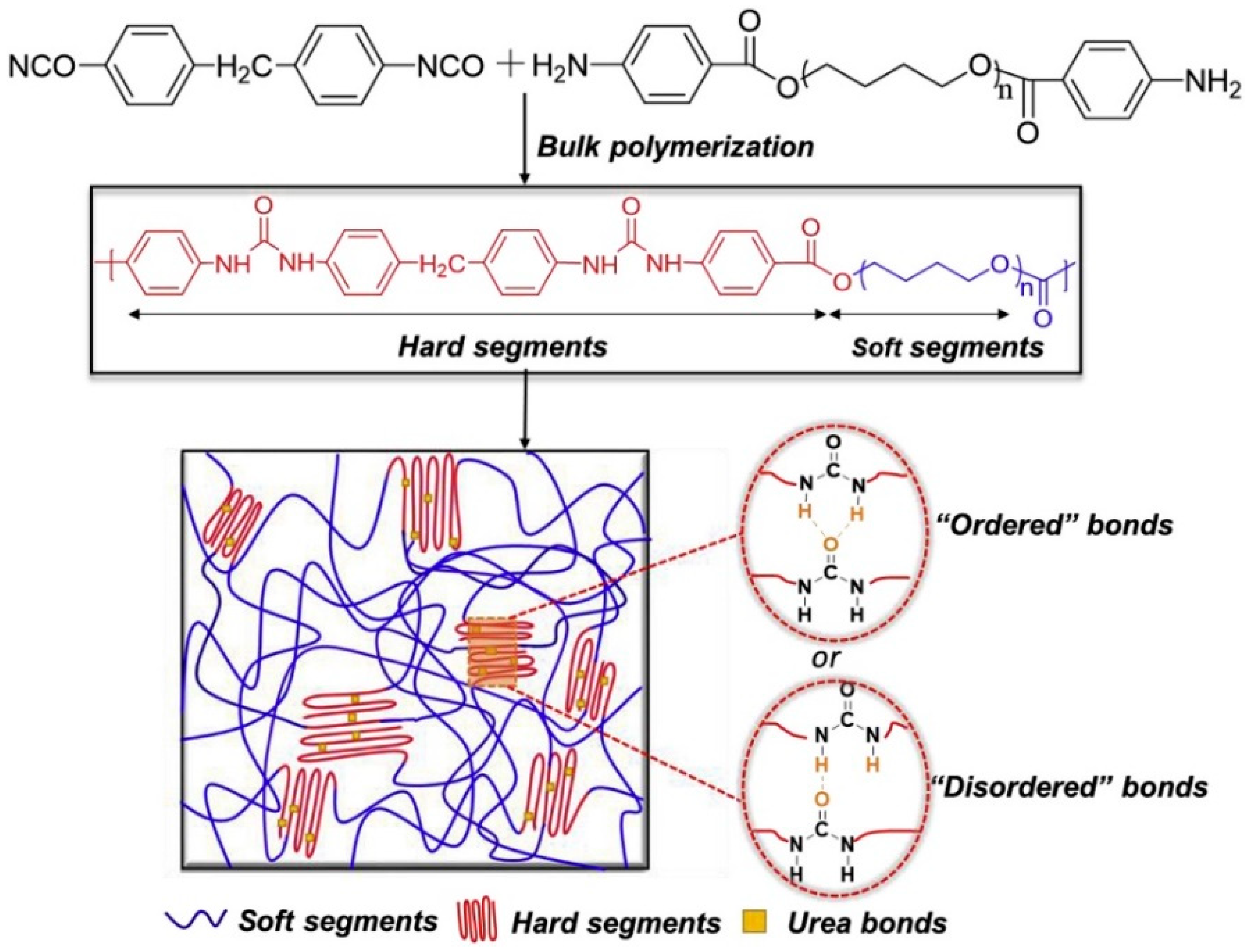
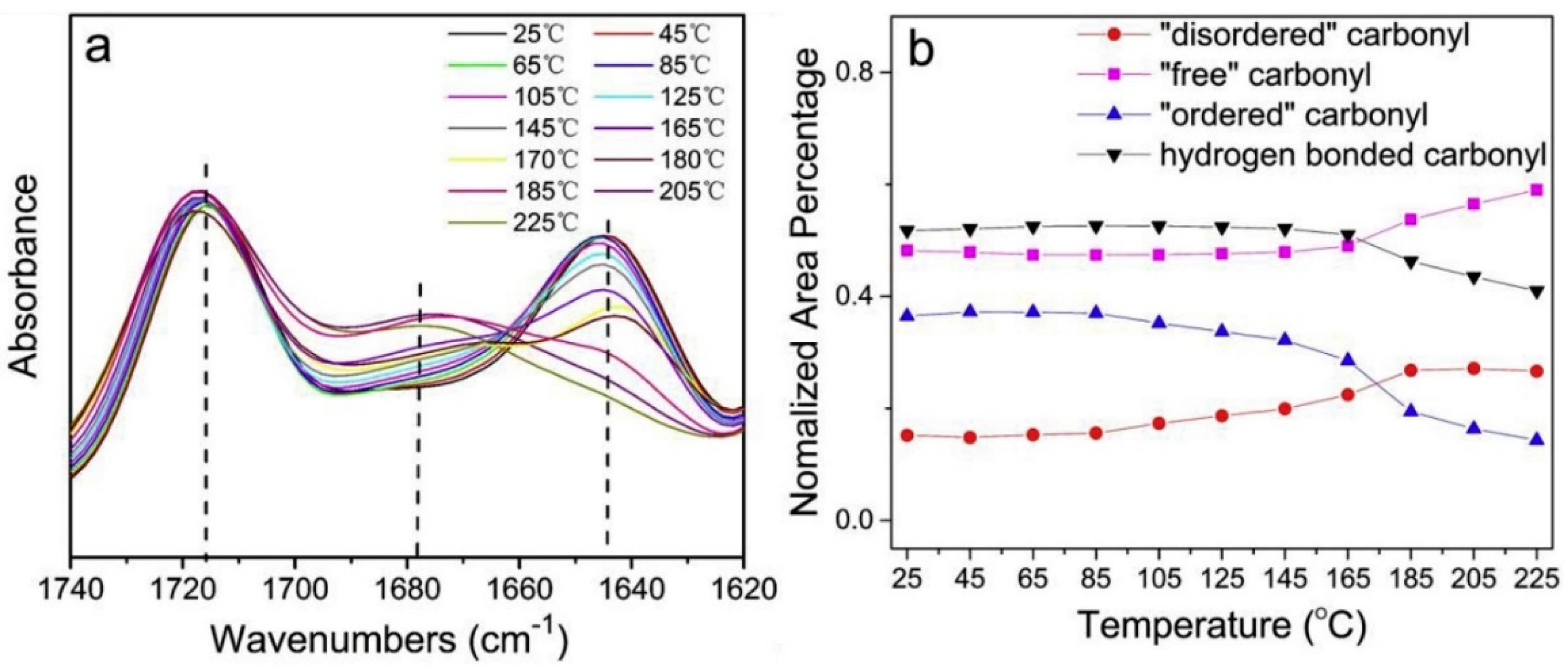
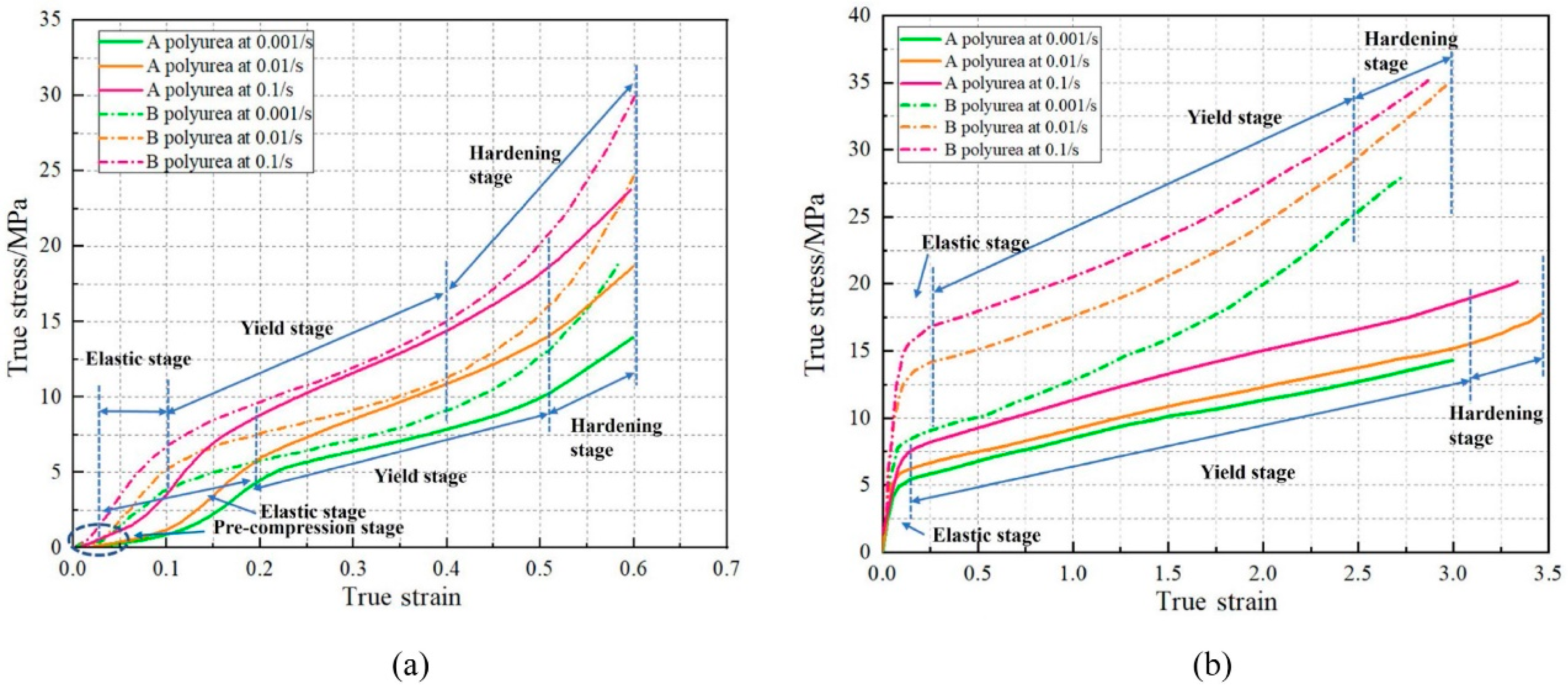
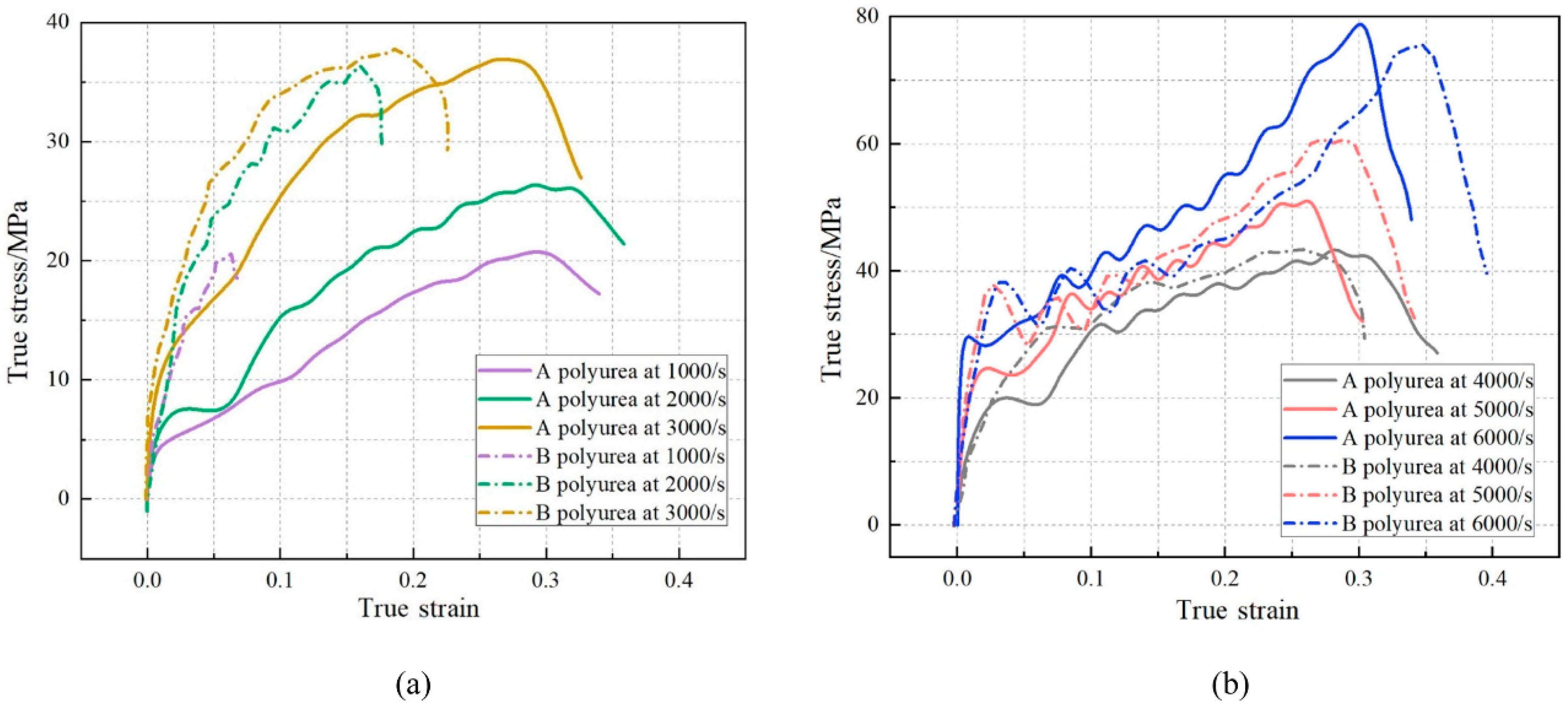
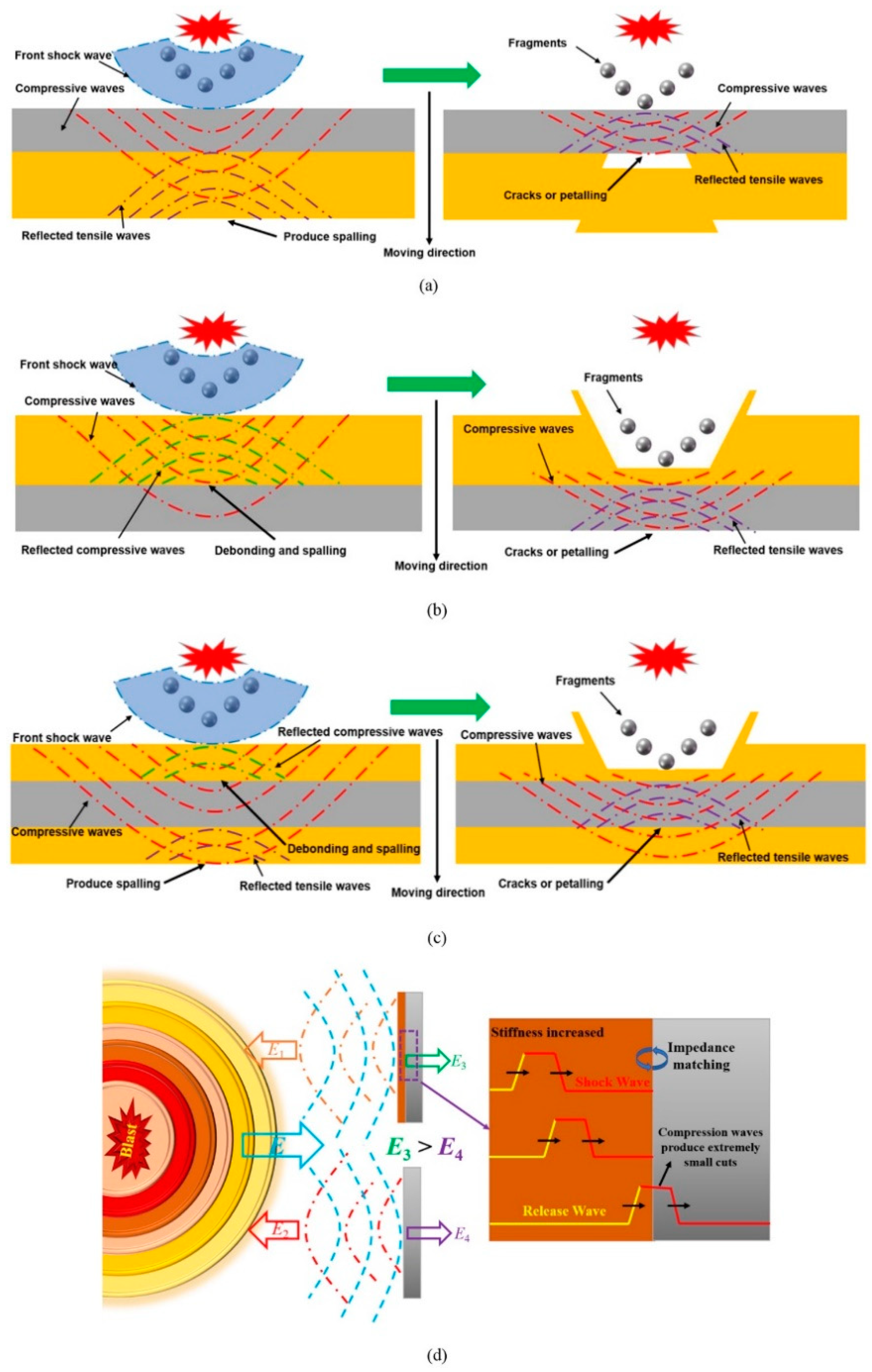
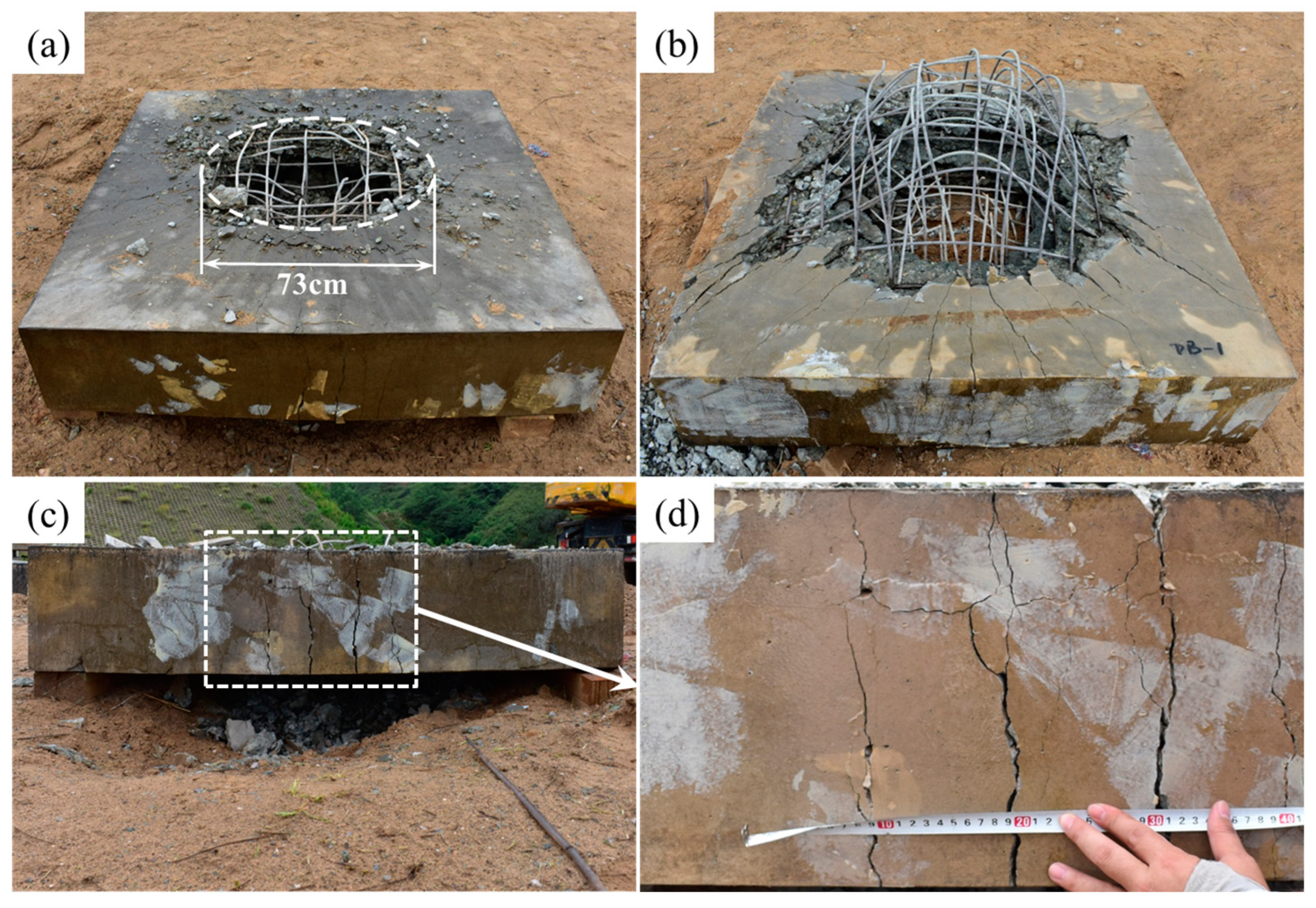


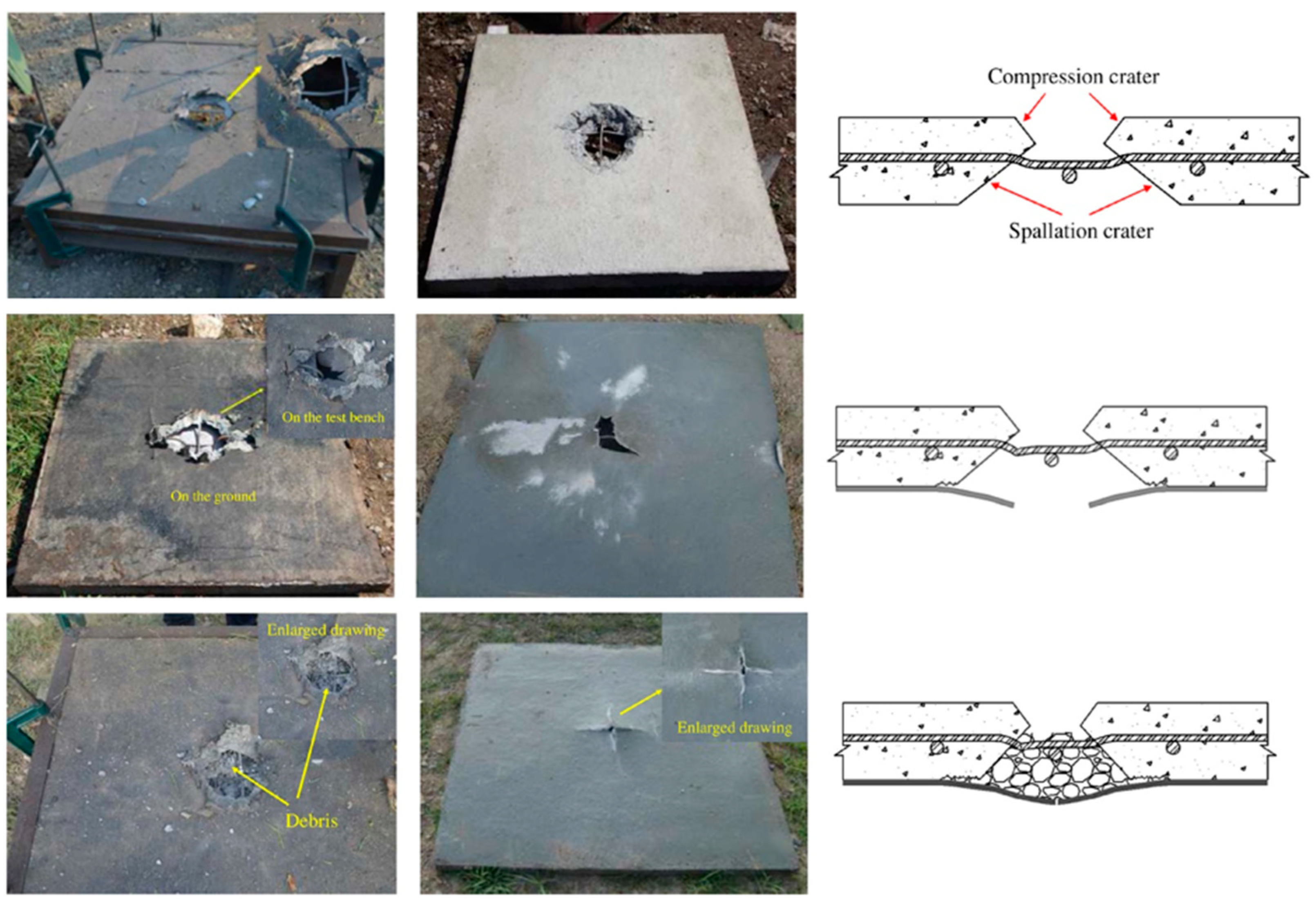

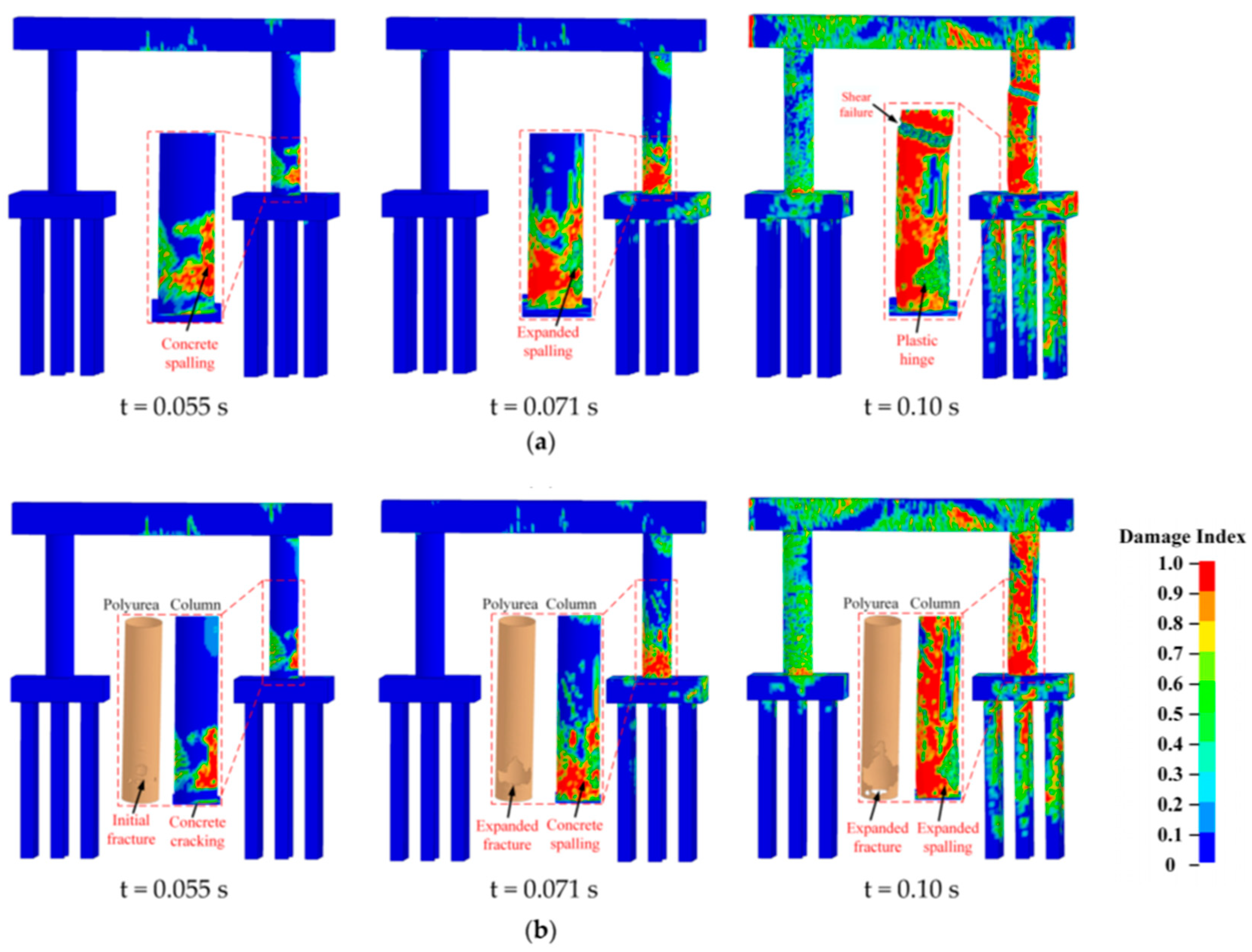
Disclaimer/Publisher’s Note: The statements, opinions and data contained in all publications are solely those of the individual author(s) and contributor(s) and not of MDPI and/or the editor(s). MDPI and/or the editor(s) disclaim responsibility for any injury to people or property resulting from any ideas, methods, instructions or products referred to in the content. |
© 2024 by the authors. Licensee MDPI, Basel, Switzerland. This article is an open access article distributed under the terms and conditions of the Creative Commons Attribution (CC BY) license (https://creativecommons.org/licenses/by/4.0/).
Share and Cite
Wang, Y.; Ding, L.; Lin, J.; Qiu, X.; Wu, C.; Liu, C.; Tian, Y.; Zhang, R.; Huang, W.; Ma, M. Recent Developments in Polyurea Research for Enhanced Impact Penetration Resistance and Blast Mitigation. Polymers 2024, 16, 440. https://doi.org/10.3390/polym16030440
Wang Y, Ding L, Lin J, Qiu X, Wu C, Liu C, Tian Y, Zhang R, Huang W, Ma M. Recent Developments in Polyurea Research for Enhanced Impact Penetration Resistance and Blast Mitigation. Polymers. 2024; 16(3):440. https://doi.org/10.3390/polym16030440
Chicago/Turabian StyleWang, Yifan, Lailong Ding, Jiayu Lin, Xishun Qiu, Chao Wu, Changhao Liu, Yicheng Tian, Rui Zhang, Weibo Huang, and Mingliang Ma. 2024. "Recent Developments in Polyurea Research for Enhanced Impact Penetration Resistance and Blast Mitigation" Polymers 16, no. 3: 440. https://doi.org/10.3390/polym16030440
APA StyleWang, Y., Ding, L., Lin, J., Qiu, X., Wu, C., Liu, C., Tian, Y., Zhang, R., Huang, W., & Ma, M. (2024). Recent Developments in Polyurea Research for Enhanced Impact Penetration Resistance and Blast Mitigation. Polymers, 16(3), 440. https://doi.org/10.3390/polym16030440






